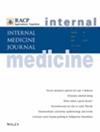Characteristics and management of eosinophilic esophagitis in Australasian children: a decade of experience
Abstract
Background
The frequency of EoE has been increasing in Northern Hemisphere cohorts, yet there is a scarcity of data in our region. Regional climatic factors, and lifestyle habits may influence the presentation of EoE, and appropriate management is crucial to prevent complications. WIth this is mind we undertook the first comprehensive multisite study of EoE in Australasian children.
Aim
To determine the incidence, prevalence, clinical characteristics and management of eosinophilic esophagitis (EoE) in Australasian children.
Methods
Retrospective audit of endoscopic records, histology reports and case notes (ICD code) over a 10-year period (1 January 2008 to 31 December 2018). Cases were defined as having >15 eosinophils per high-power field (HPF) at endoscopy and oesophageal biopsy, while treatment response was defined as <5 eosinophils per HPF. Included were patients aged 0–18 years presenting to tertiary paediatric hospitals in seven capital cities (Adelaide, Auckland, Brisbane, Christchurch, Melbourne, Perth and Sydney), while those with conditions that could cause eosinophilia (organ transplantation, hyper-eosinophilic syndrome) or taking medications that may influence tissue eosinophilia (systemic corticosteroids immunosuppressants) were excluded. Australian Bureau of Statistics and Stats NZ were used to define comparative population data. Demographics (age at diagnosis, gender, country of birth, race) comorbidities (atopic conditions, e.g. asthma, seasonal rhinitis, eczema) and treatment (diet, steroids, proton pump inhibitors) were noted.
Results
The prevalence of EoE ranged from 15 to 54 per 100 000 children, where cases were more common in Adelaide than other localities. Incidence increased significantly in all sites across the 10 years, with peak incidence in Adelaide of 6.4 per 100 000 children in 2017. EoE was most frequent in males (male:female ratio = 3:1) and >90% were white Caucasian. Polynesian racial background in Auckland (10%) and middle eastern racial background in Sydney (10%) were the next most frequent. Treatment choice varied across sites, and greater than 30% of patients did not undergo endoscopy to assess initial treatment success.
Conclusion
The prevalence of EoE in Australasian children is comparable to that observed elsewhere, and the incidence is increasing significantly. Regional differences in disease frequency, management practices and access to endoscopy warrant further study.

 求助内容:
求助内容: 应助结果提醒方式:
应助结果提醒方式:


